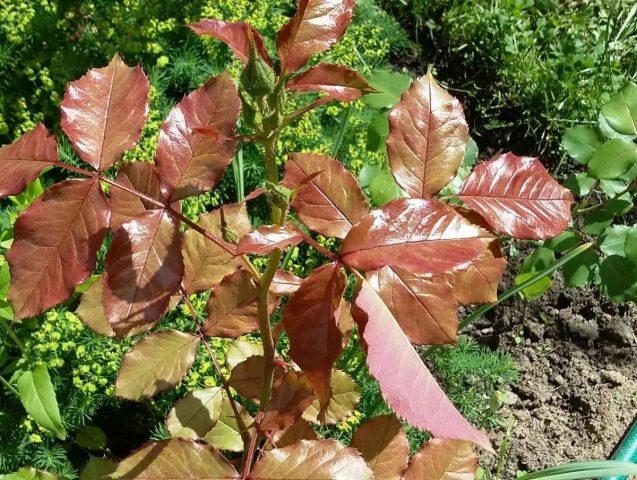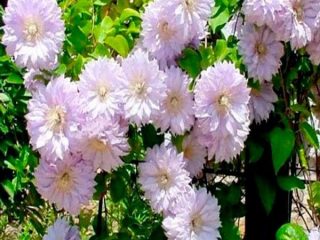Content
The leaves of the rose turn red - a problem that gardeners and summer residents quite often encounter when growing this beautiful plant. The reasons for changes can be several factors that you need to try to identify and eliminate in time. The fact is that this phenomenon can not only be natural, but also arise due to a specific problem that can provoke both disease and death of the bush.

The leaf blades of healthy roses should be green, not red.
Why did the leaves of the rose turn red?
The appearance of a red tint on the stems and leaves of roses sometimes leads gardeners to bewilderment, because because of this the plant begins to lose its decorative qualities and looks unnatural compared to other green crops. In order to make sure whether this phenomenon poses a danger to the crop, the first thing you need to do is examine the bush and try to determine the cause of the disease. Red leaves on roses can appear both due to natural changes - a feature of the variety, and due to unnatural processes: lack of nutrients, disease, insect attacks.
Natural causes
It is not considered a pathology if the leaf blades of a rose become red in certain varieties, since the green mass of some representatives of the crop in the spring always acquires a shade that disappears over time. Some specimens may have burgundy petals due to incomplete production of the bright pigment. And sometimes the stems and leaf blades become an unnatural red color after transplantation, due to a stressful situation.
Nutritional deficiencies
A fairly common cause of reddening of rose leaves is a lack of nutrients. For example, with a lack of nitrogen, red spots appear on old leaf blades, but young specimens remain green. In case of phosphorus deficiency, a lilac edging is added to the burgundy color. If the plant lacks magnesium, the changes affect only the veins of the rose leaves. And in the case when the leaf first turns yellow and then turns red, the plant needs calcium.

When redness of the foliage of a rose appears due to lack of nutrition, you need to properly fertilize the bushes
Diseases
The most common and most dangerous reasons for the appearance of red leaves on a rose in spring and autumn are diseases and pests. If they are detected in time, then with a high probability the plant can be restored to health and beauty and cope with the danger.Among the most common crop diseases that provoke redness of the green mass are:
- powdery mildew;
- cancer;
- rust;
- spotting.
Sources of diseases can be insect pests: thrips, aphids, caterpillars. They can also occur due to improper care.
What to do if the leaves of a rose turn red
When rose leaves turn red for unnatural reasons, the gardener needs to take a number of measures. The first thing you need is to conduct a visual inspection of the plant. If damage is found on one or more shoots that could provoke infection, they should be covered with coal or lubricated with garden varnish. In a situation where the flower is constantly in the sun, you need to try to shade it with a hedge or transplant it to a place more protected from direct sunlight.
If the leaves and shoots of a crop become red due to a disease, it is recommended to correctly determine its type and begin treatment as soon as possible:
- Powdery mildew. The first symptom of the disease is the appearance of red foliage or yellow spots on it. Over time, the plates begin to curl and fall off. To combat the disease, products containing large amounts of copper are used.
Powdery mildew usually occurs due to a lack of phosphorus-potassium fertilizers
- Stem cancer. Often causes the appearance of red color on leaves and stems in the spring, after removing the cover. Over time, the affected areas crack and form ulcers.If a disease is detected, the damaged parts of the plant are removed, and the bush is treated with copper sulfate or fungicides.
Stem canker is also called rose blight.
- Rust. It first appears as yellow spots, then their color becomes brown or red. If the crop is not treated in time with Bordeaux mixture or fungicidal preparations, the disease will develop into spotting, the bush will begin to dry out, and its green parts will fall off.
Rust is a dangerous disease that, if not treated promptly, causes the death of the flower.
Prevention of leaf redness
To prevent rose leaves from turning red in the garden or dacha, the gardener should periodically inspect the flower beds and prevent illnesses. Without timely detection of deviations, proper organization of care, watering, fertilization, treatment of diseases, beautiful flowering of the crop can not be expected.
The main preventive measures against the appearance of red leaves on a rose include:
- Moistening the flower. It is recommended to carry it out as needed, since excess moisture or its deficiency can lead to external deviations in the form of red foliage and more. In rainy weather, the plant is watered infrequently.
- Feeding. Fertilize the bushes in accordance with the schedule, with preparations containing the necessary components. All nutrient mixtures are added before July.
- Shelter. It is advisable to cover the plant shoots with special covers or any other suitable materials from the summer heat and winter frosts. Cases where rose leaves turn red due to excess light or frostbite occur quite often in gardening practice.
- Preventive spraying.To prevent the development of diseases or insect infestations, flower beds with roses should be treated with copper sulfate and soap solution several times a season. It is also necessary to periodically irrigate with Bordeaux mixture.

Care of the rose garden should be performed exclusively with disinfected tools.
Conclusion
Rose leaves turn red both due to external factors and due to natural causes. Before starting to correct the situation, the gardener is recommended to carefully examine the bush and determine the factor influencing the change in the shade of the plates. In case of varietal peculiarities or stress, there is no need for additional measures, but if there is a lack of nutrition or a disease occurs, it is necessary to feed the bushes or treat the entire flowerbed with special control agents.











